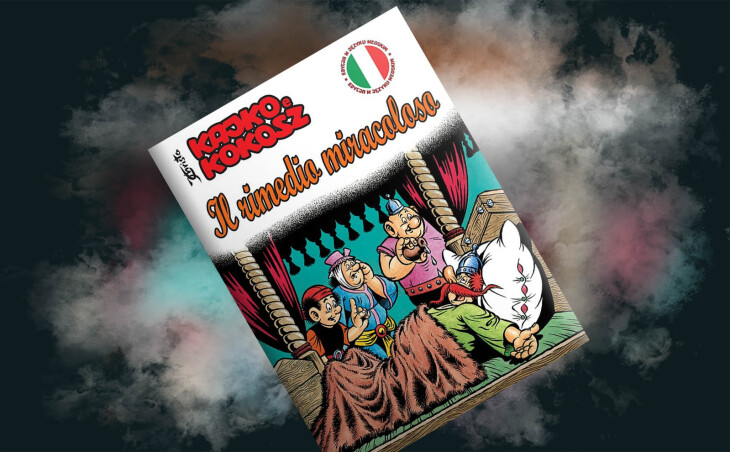Reviewing Kajek and Kokosz is a real art, especially when a lot has been said about them. Older readers can only be surprised by new adventures, while young ones have the opportunity to get acquainted with the classics published in “Świat Młodych”. What about publishing their stories in other languages?
A quick reminder
What is the comic book titled Miracle Drug actually about ? The robbers decide to use the sick Corporal as a biological weapon and thus get rid of the village leader Kajka and Kokosz , i.e. Mirmiłów. Only the water from Pochwist’s spring can cure him, so dedicated warriors, one big, one small, go after her. Unfortunately, the source is poisoned and they must overcome many obstacles to break the poison spell.
In Dante’s language
I suspect that when the action of the Polish adventures of Asterix and Obelix takes place, we had the early Middle Ages, and paganism was still dominant in Polish lands, so in Western Europe – Christianity and Latin. Italian was born only later. I must admit that Mrs. Urszula Buczkowska-Marchetti – an Italianist who is both a teacher and a translator – and Maurizio Marchetti rose to the occasion, especially since it was the first translation into Petrarch’s language.
What interested me most? That such names as “Hegemon” were literally translated as Egemon , “Corporal” as Caporale , and “Castellan” as Castellano . Some letters have also been changed, such as “y” to “i”, to make Rubrik’s name easier to read . I was most happy about Mocarz Stobij – Potente Centocolpi , which literally translates to Strong Stobij . A true masterpiece! Similarly, we have the “robbers”, who are called in the commission brigandieri from the term brigante meaning robbers, which in free translation can mean “members of robbers”. The word “vegetarian” has been translated simply as vegetariano. We have a similar situation with the little used today “offer”, which was called a clumsy, i.e. imbranato. In turn, “Mirmił” was diminutively named as the gladiator mirmillo, which in Roman times was characterized by the fact that it had a helmet with a wide flat brim and a large metal crest on top.
I’m not surprised, however, that the name of the dragon was not changed and it was simply Milus. Well, it’s hard to find an adequate word, because we can use either Bello , Carino or Simpatico , but none of these words carry the same meaning as the Polish Miluś, referring to a “miluśki” pet. Hence, as you know, not everything can be translated 1:1. There are more examples of this type in the comic, such as Kokosz’s battle cry “Jahu!”.
Of course, there were also translations with which I do not fully agree. The scene in which Kokosz announces that all they have left is a “landscape” translated as a classic view – classica veduta . For me, landszaft is a contemptuous term for a landscape, according to the PWN Polish Language Dictionary. Why such a discrepancy?
Is it worth learning languages?
Philologists and language enthusiasts like me were eager to see how Kajek and Kosz’s other adventures were translated into other languages. I would probably like to use Spanish, which I work with every day, but also English, Latin or Euskara. If it works out, I’d love to see Arabic as well (although here it may take a while, because I’m still in the woods when it comes to knowing the Arabic language). With time, I will also return to the French version of On Vacation and the Ukrainian Grand Tournament. Reading this type of comics increases our ability to assimilate new words and makes it possible to broaden our horizons when talking to our friends abroad, freely using proper names that have been given by translators. Fantasy lovers of all countries – unite! I am not a specialist in the Italian language, however, because of my roots and family from the Apennine Peninsula, I undertook the task of reading this comic book and I think it was a really great adventure. In addition, I am waiting for the next editions of the adventures of Kajka and Kokosz from Egmont in foreign languages.

